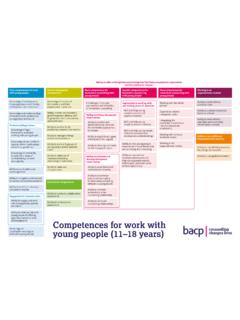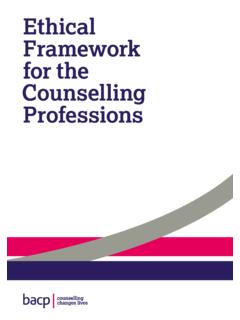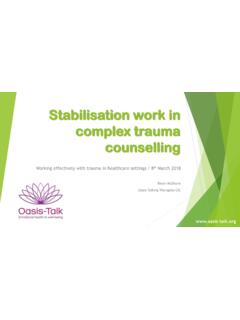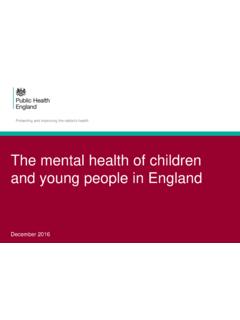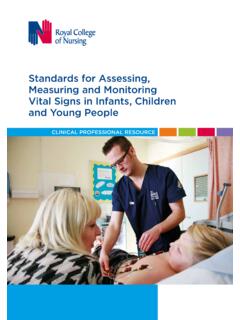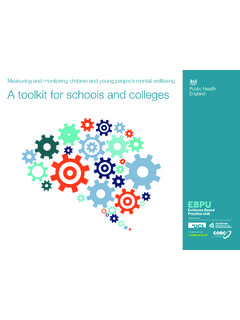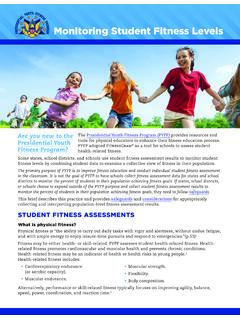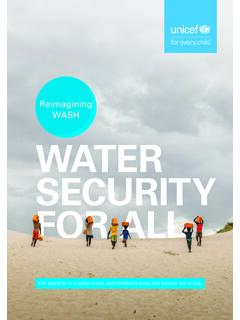Transcription of Children and Young People Practice Research Network (CYP …
1 A toolkit for collecting routine outcome measuresChildren and Young People Practice Research Network (CYP PRN):b BACP 2016 Children and Young People Practice Research Network (CYP PRN) Children and Young People Practice Research Network (CYP PRN): A toolkit for collecting routine outcome measures is published by the British Association for Counselling & Psychotherapy, BACP House, 15 St John s Business Park, Lutterworth, Leicestershire, LE17 : 01455 883300f: 01455 550243e: is the largest professional organisation for counselling and psychotherapy in the UK, is a company limited by guarantee 2175320 in England and Wales, and a registered charity, 298361. British Association for Counselling & Psychotherapy 2016.
2 First published further information regarding any content contained in this document contact:Dr Jo Pybis, Research Facilitator BACPe: This is a working document that may be revised and updated over timeAcknowledgementsWe would like to thank a number of People who have contributed to the development of this guidance document. Firstly the members of the Children and Young People Practice Research Network (CYP PRN) steering group (Karen Cromarty, Terry Hanley, Andy Hill, Hillary Hill, Charlotte Jackson, Peter Jenkins, Katherine McArthur, Aaron Sefi, Caryl Sibbett, Dave Stewart, Jo Pybis). In addition we d like to thank the members of the Network who participated in the pilot study and interviews which helped ensure this document was fit for purpose.
3 We d like to thank CORC for their support and advice, specifically Miranda Wolpert, Andy Fugard and Jenna Bradley. Thanks also go to Nancy Rowland, Mick Cooper, Angela Couchman and Clare Catherall for reading and commenting on earlier drafts. Finally thanks to all members of the CYP PRN we hope you find this document work is copyright. It may be reproduced in whole or in part for study or training purposes subject to the inclusion of an acknowledgment of the source and no commercial usage or sale. Reproduction for other purposes than those indicated above requires written permission of the copyright holder, application for which should be addressed to the Chief Executive at BACP.
4 I BACP 2016A toolkit for collecting routine outcome measures1. Introduction Why collect routine outcome data? What kinds of questions can routine outcome data answer? Feedback from CYP PRN members on the use of routine outcome measures 12. How to collect data Gaining informed consent from clients The need to collect measures every session Which measures should I be using? When should I be using each measure? 33. Information about the measures Strengths and Difficulties Questionnaire (SDQ) (11 16 years self-report, 4 16 years parent rated) 5 Strengths and Difficulties Questionnaire follow up (11 16 years self-report, 4 16 years parent rated) Young Person s CORE (YP-CORE) (11 16 years) Clinical Outcomes in Routine Evaluation (CORE-10) (16+ years) Goal Based Outcomes (0 18 years) Revised Children s Anxiety and Depression Scale (RCADS) (8 18 years) Rosenberg Self Esteem Scale (SEQ) Outcome rating scale (ORS)/Session rating scale (SRS) (13+ years) 6 Child outcome rating scale (CORS) / Child session rating scale (CSRS) (6 12 years) Satisfaction survey (Chi-ESQ)
5 (9 11 years) 6 Satisfaction survey (Chi-ESQ) (12 18 years) 64. Options for inputting data 75. References 8 ContentsII BACP 2016 Children and Young People Practice Research Network (CYP PRN)6. Appendix 9 Appendix I: Overview of findings from the pilot study 9 Appendix II: Example client information sheet and consent form 10 Appendix III: Client demographic information 11 Appendix IV: Presenting issues 12 Appendix V: Copies of the measures 12 Self-report measures 13 Strengths and Difficulties Questionnaire (SDQ) (11 16 years) 14 Strengths and Difficulties Questionnaire follow up (11 16 years) 16 Young Person s CORE (YP-CORE) (11 16 years) 18 Clinical Outcomes in Routine Evaluation (CORE-10) (16+ years) 19 Goal Based Outcomes (0 18 years) 20 Revised Children s Anxiety and Depression Scale (RCADS) (8 18 years) 22 Rosenberg Self Esteem Scale (SEQ) 24 Outcome rating scale (ORS) 25 Session rating scale (SRS) (13+ years) 26 Child outcome rating scale (CORS) 27 Child session rating scale (CSRS) (6 12 years) 28 Satisfaction survey (Chi-ESQ) (9 11 years) 29 Satisfaction survey (Chi-ESQ)
6 (12 18 years) 31 Parent/carer measures 33 Strengths and Difficulties Questionnaire (SDQ) (4 16 years) 34 Strengths and Difficulties Questionnaire (SDQ) follow up (4 16 years) 36 Revised Child Anxiety and Depression Scale (RCADS) (8 11 years) 38 Satisfaction survey (Chi-ESQ) 40 Teacher measures 43 Strengths and Difficulties Questionnaire (SDQ) (4 16 years) 44 Strengths and Difficulties Questionnaire (SDQ) follow up (4 16 years) 46 How to score the measures 49 III BACP 2016A toolkit for collecting routine outcome measures01 BACP 2016 Children and Young People Practice Research Network (CYP PRN)1. IntroductionA key benefit of being part of a Practice Research Network (PRN) is for practitioners and researchers to work collaboratively to collect and analyse data across services.
7 This toolkit aims to provide counsellors working with Children and Young People with practical information on how to collect data using routine outcome measures and how to feed this data into the BACP Children and Young People Practice Research Network (CYP PRN) to help to evaluate services and develop the evidence have joined the Child Outcomes Research Consortium (CORC) which is a collaboration of researchers and mental health specialists. Membership of CORC allows us to gain support in the collection and analysis of routine outcome data, and the use of electronic software which can make it easier to collect outcomes information during therapy, for instance scoring questionnaires, providing information on clinical bands, and graphing Why collect routine outcome data?
8 Young services users have indicated that they want to collaborate in service development and see the use of feedback and outcome tools as an important aspect of this process ( Young Minds Talking about Talking Therapies, 2011).The use of evaluation and outcome measures should be practiced in accordance with the BACP Ethical Framework for the Counselling Professions. Outcome measures should be used as part of routine therapy, rather than as an adjunct to it; in a manner in which they are of benefit to each client and enrichment of each clinical engagement. BACP s Ethical Framework highlights the importance of using Research to inform Practice : We value Research and systematic inquiry by practitioners as enhancing our professional knowledge and providing an evidence-base for Practice in ways that benefit our clients.
9 The Framework also explains that all participants in Research will do so on the basis of explicit informed consent .Routine outcome measures support the therapeutic process by enabling the therapist and the client to monitor progress (Harmon et al., 2007; Lambert and Shimokawa, 2011; Simon et al., 2012), and can play an important role in measuring service quality and lead to improvements. An additional benefit is to provide evidence of the effectiveness of counselling and psychotherapy which has the potential to influence commissioners and What kinds of questions can routine outcome data answer?Routine outcome data can be used to answer questions regarding the effectiveness of an intervention.
10 It is necessary to collect this type of data on a large scale and, collate the data, which can then be analysed using statistical methods to provide what is known as an effect size for how effective the therapy has been. At a higher level, it is possible for this kind of data to be combined with other information such as the therapists modality (eg. Humanistic, CBT, Psychodynamic etc.) and the clients demographic information (eg. gender, age, ethnicity, presenting issues etc.) which can be analysed to help answer the question of what works for whom? .In real world settings as opposed to being part of a randomised controlled trial, clients often do not complete all therapy outcome measures (Barkham et al.)
